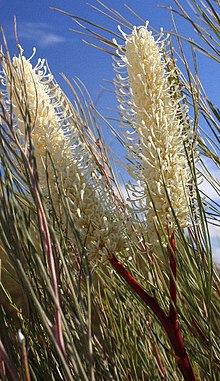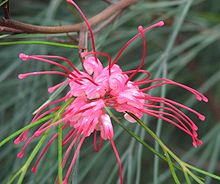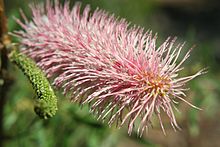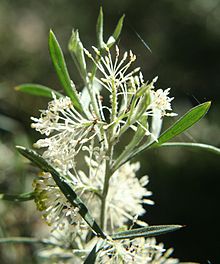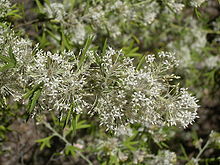Grevilleen
| Grevilleen | ||||||||||||
|---|---|---|---|---|---|---|---|---|---|---|---|---|

Grevillea juniperina |
||||||||||||
| Systematics | ||||||||||||
|
||||||||||||
| Scientific name | ||||||||||||
| Grevillea | ||||||||||||
| R.Br. ex Knight |
The Grevillea or silver ( Grevillea ) are a genus of plants within the silver tree family (Proteaceae).
description
Grevillea species grow as evergreen , mostly upright or creeping shrubs , some species also as trees , with heights of between 0.5 and 35 meters, depending on the species. The leaves are sessile or stalked, depending on the species. The leaf blades are simple, smooth or toothed, or divided with up to three levels of division. The leaf margin is flat or bent back. There is pinnate and reticular or parallel nerve.
The hermaphrodite flowers are also stalked or sessile, depending on the species. They are usually in pairs with a common bract , arranged in multiple inflorescences . The perianth is usually zygomorphic with bent-back ends, sometimes also regular with upright ends. There are usually four, three rare bloom present, the separate on flowering, so the stylus to release end. The bracts are smooth or hairy on both sides. The anthers sit directly on the bracts. The nectar glands are whole or ring-shaped, rarely absent or four-fold. The ovary is bald or hairy. The sessile or stalked Upper constant ovary contains only two ovules . The disc-shaped or conical stigma is upright or oblique to the side of the style.
The bald or hairy fruits are usually follicles or, more rarely (for example in Grevillea candicans ) an achenes and contain only one or two seeds. Depending on the species, they stay on the plant for a long time or fall off early. The pericarp is often hard-shelled. The mostly flat ellipsoidal, rarely hemispherical seeds are winged or wingless.
distribution
The Grevillea species are native to Australia , New Guinea , New Caledonia and the Indonesian island of Sulawesi . Almost all species are native to Australia. Only five species are found in areas outside of Australia: Grevillea exul , Greviileea gillvayi and Grevillea meisneri are native to New Caledonia. Grevillea elbertii and Grevillea papuana are native to Sulawesi and New Guinea. Two other species, Grevillea baileyana and Grevillea glauca , occur in New Guinea and Queensland , Australia .
Systematics
The first description from 1809 in Joseph Knight : On the cultivation of the plants belonging to the natural order of Proteeae. P. 120 uses the notation "Grevillia". Type species is Grevillea aspleniifolia R.Br. ex Knight. The homonym Grevillea LC Beck & Emmons was published in 1826 in the American Journal of Science, and Arts , Volume 11, Plate 1. The generic name Grevillea honors Charles Francis Greville (1749-1809), a member of the Royal Society and the Linnean Society of London .
The genus Grevillea includes around 360 species. Here is a relatively arbitrary list of species of the genus Grevillea :
- Grevillea acacioides
- Grevillea acanthifolia A. Cunn.
- Grevillea acerata
- Grevillea acerosa F. Muell.
- Grevillea acrobotrya
- Grevillea acropogon
- Grevillea acuaria
- Grevillea adenotricha
- Grevillea agrifolia
- Grevillea albiflora
- Grevillea alpina Lindl. (Syn .: Grevillea dallachiana F. Muell. Nom. Nud.)
- Grevillea alpivaga
- Grevillea althoferorum
- Grevillea amplexans
- Grevillea anethifolia
- Grevillea aneura
- Grevillea angulata
- Grevillea angustiloba
- Grevillea annulifera F. Muell.
- Grevillea aquifolium Lindl.
- Grevillea arenaria R.Br.
- Grevillea argyrophylla
- Grevillea armigera
- Grevillea asparagoides
- Grevillea aspera R.Br.
- Grevillea aspleniifolia Knight
- Grevillea asteriscosa
- Grevillea aurea
- Grevillea australis R.Br.
- Grevillea baileyana McGill. (Syn .: Grevillea pinnatifida (FMBailey) FMBailey ; Kermadecia pinnatifida F.M.Bailey )
- Red flowering silver areas ( Grevillea banksii R.Br. )
- Grevillea banyabba
- Grevillea barklyana F. Muell. ex Benth.
- Grevillea batrachioides
- Grevillea baueri
- Grevillea baxteri
- Grevillea beadleana
- Grevillea beardiana
- Grevillea bedggoodiana
- Grevillea benthamiana
- Grevillea berryana
- Grevillea biformis
- Grevillea bipinnatifida R.Br.
- Grevillea brachystachya
- Grevillea brachystylis Meisn.
- Grevillea bracteosa Meisn.
- Grevillea brevifolia
- Grevillea brevis
- Grevillea bronwenae
- Grevillea buxifolia (Sm.) R.Br. (Syn .: Embothrium buxifolium Sm. )
- Grevillea byrnesii
- Grevillea cagiana
- Grevillea calcicola
- Grevillea caleyi R.Br.
- Grevillea calliantha
- Grevillea candelabroides C.A. Gardner
- Grevillea candicans C.A. Gardner
- Grevillea candolleana
- Grevillea capitellata
- Grevillea celata
- Grevillea centristigma
- Grevillea ceratocarpa
- Grevillea cheilocarpa
- Grevillea christineae
- Grevillea chrysophaea
- Grevillea cirsiifolia
- Grevillea coccinea
- Grevillea commutata
- Grevillea concinna
- Grevillea confertifolia F. Muell.
- Grevillea coriacea
- Grevillea corrugata
- Grevillea costata
- Grevillea crassifolia
- Grevillea cravenii
- Grevillea crithmifolia R.Br.
- Grevillea crowleyae
- Grevillea cunninghamii
- Grevillea curviloba McGill.
- Grevillea cyranostigma
- Grevillea decipiens
- Grevillea decora
- Grevillea decurrens
- Grevillea deflexa
- Grevillea delta
- Grevillea depauperata R.Br.
- Grevillea didymobotrya
- Grevillea dielsiana C.A. Gardner
- Grevillea diffusa
- Grevillea dilatata
- Grevillea dimidiata F. Muell.
- Grevillea diminuta
- Grevillea disjuncta
- Grevillea dissecta
- Grevillea divaricata
- Grevillea diversifolia
- Grevillea dolichopoda
- Grevillea donaldiana
- Grevillea drummondii (W. Fitzg.) McGill.
- Grevillea dryandri
- Grevillea dryandroides
- Grevillea dryophylla
- Grevillea dunlopii
- Grevillea elongata
- Grevillea endlicheriana Meisn.
- Grevillea epicroca
- Grevillea erectiloba
- Grevillea erinacea
- Grevillea eriobotrya
-
Grevillea eriostachya Lindl.
- Grevillea eriostachya subsp. eriostachya
- Grevillea eriostachya subsp. excelsior (Diels) McGill. (Syn .; Grevillea excelsior Diels )
- Grevillea eryngioides
- Grevillea erythroclada
- Grevillea evanescens
- Grevillea evansiana
- Grevillea exposita
- Grevillea extorris
- Grevillea exul
- Grevillea fasciculata R.Br.
- Grevillea fastigiata
- Grevillea fililoba (McGill.) Olde & Marriott
- Grevillea fistulosa
- Grevillea flexuosa (Lindl.) Meisn.
- Grevillea floribunda R.Br.
- Grevillea florida
- Grevillea floripendula
- Grevillea formosa
- Grevillea fulgens
- Grevillea fuscolutea
- Grevillea gariwerdensis
- Grevillea georgeana
- Grevillea gillivrayi
- Grevillea glabrescens
- Grevillea glauca
- Grevillea globosa
- Grevillea glossadenia
- Grevillea goodii
- Grevillea gordoniana C.A.Gardner
- Grevillea granulifera
- Grevillea granulosa
- Grevillea guthrieana
- Grevillea hakeoides
- Grevillea halmaturina
- Grevillea haplantha
- Grevillea heliosperma R.Br.
- Grevillea helmsiae
- Grevillea hilliana F. Muell.
- Grevillea hirtella
- Grevillea hockingsii
- Grevillea hodgei
- Grevillea hookeriana Meisn. (Syn .: Grevillea pritzelii Diels )
- Grevillea huegelii Meisn.
- Grevillea humifusa Olde & Marriott
- Grevillea humilis
- Grevillea iaspicula
- Grevillea ilicifolia (R.Br.) R.Br. (Syn .: Anadenia ilicifolia R. Br. )
- Grevillea imberbis
- Grevillea inconspicua
- Grevillea incrassata
- Grevillea incurva
- Grevillea infecunda
- Grevillea infundibularis
- Grevillea insignis
- Grevillea integrifolia
- Grevillea intricata Meisn.
- Grevillea involucrata
- Grevillea irrasa
- Grevillea jephcottii
- Grevillea johnsonii McGill.
- Grevillea juncifolia Hook.
- Grevillea juniperina R.Br.
- Grevillea kedumbensis
- Grevillea kenneallyi
- Grevillea kennedyana
- Grevillea kirkalocka
- Grevillea lanigera A. Cunn. ex R.Br. (Syn .: Grevillea ericifolia R. Br. )
- Grevillea latifolia
- Grevillea laurifolia Sieber ex Spreng.
- Grevillea lavandulacea Schltdl.
- Grevillea leiophylla
- Grevillea leptobotrys
- Grevillea leptopoda McGill.
- Grevillea leucoclada
- Grevillea leucopteris Meisn.
- Grevillea levis
- Grevillea linearifolia (Cav.) Druce (Syn .: Grevillea linearis (Andrews) R.Br. )
- Grevillea linsmithii
- Grevillea lissopleura
- Grevillea longicuspis
- Grevillea longifolia R.Br.
- Grevillea longistyla
- Grevillea lullfitzii
- Grevillea maccutcheonii
- Grevillea macleayana
- Grevillea maherae
- Grevillea makinsonii
- Grevillea manglesii
- Grevillea manglesioides
- Grevillea marriottii
- Grevillea masonii
- Grevillea maxwellii
- Grevillea meisneri
- Grevillea metamorpha
- Grevillea micrantha
- Grevillea microstegia
- Grevillea microstyla
- Grevillea mimosoides R.Br.
- Grevillea miniata W. Fitzg.
- Grevillea minutiflora
- Grevillea miqueliana F. Muell.
- Grevillea mollis
- Grevillea molyneuxii
- Grevillea monslacana
- Grevillea montana
- Grevillea monticola
- Grevillea montis-cole
- Grevillea mucronulata R.Br.
- Grevillea muelleri
- Grevillea murex
- Grevillea muricata
- Grevillea myosodes
- Grevillea nana
- Grevillea nematophylla
- Grevillea neurophylla
- Grevillea newbeyi
- Grevillea ninghanensis
- Grevillea nudiflora Meisn.
- Grevillea obliquistigma
- Grevillea obtecta
- Grevillea obtusiflora
- Grevillea obtusifolia
- Grevillea occidentalis
- Grevillea oldei
- Grevillea oligantha
- Grevillea oligomera
- Grevillea olivacea
- Grevillea oncogyne
- Grevillea oxyantha
- Grevillea pachylostyla
- Grevillea paniculata Meisn. (Syn. Grevillea biternata Meisn. )
- Grevillea papillosa
- Grevillea paradoxa
- Grevillea parallela Knight
- Grevillea parallelinervis
- Grevillea parviflora
- Grevillea parvula
- Grevillea patentiloba
- Grevillea patulifolia
- Grevillea pauciflora
- Grevillea pectinata
- Grevillea petrophiloides Meisn.
- Grevillea phanerophlebia
- Grevillea phillipsiana
- Grevillea phylicoides
- Grevillea pilosa
- Grevillea pilulifera (Lindl.) Druce (Syn .: Hakea pilulifera Lindl. )
- Grevillea pimeleoides
- Grevillea pinaster
- Grevillea pinifolia
- Grevillea pityophylla
- Grevillea platypoda
- Grevillea pluricaulis
- Grevillea plurijuga
- Grevillea polyacida
- Grevillea polybotrya Meisn.
- Grevillea polybractea
- Grevillea prasina
- Grevillea preissii
- Grevillea prominently
- Grevillea prostrata
- Grevillea psilantha
- Grevillea pteridifolia Knight (Syn .: Grevillea chrysodendrum R.Br. )
- Grevillea pterosperma
- Grevillea pulchella
- Grevillea punctata
- Grevillea pungens
- Grevillea pyramidalis A. Cunn. ex R. Br.
- Grevillea pythara
- Grevillea quadricauda
- Grevillea quercifolia R.Br.
- Grevillea quinquenervis
- Grevillea ramosissima Meisn.
- Grevillea rara
- Grevillea raybrownii
- Grevillea refracta
- Grevillea renwickiana
- Grevillea repens F. Muell. ex Meisn.
- Grevillea reptans
- Grevillea rhizomatosa
- Grevillea rhyolitica
- Grevillea rigida
- Grevillea ripicola
- Grevillea rivularis L.ASJohnson & McGill
- Grevillea robusta A. Cunn. ex R.Br.
- Grevillea rogersoniana
- Grevillea rosieri
- Rosemary silver areas ( Grevillea rosmarinifolia A. Cunn. )
- Grevillea roycei
- Grevillea rubicunda
- Grevillea rudis
- Grevillea saccata Benth.
- Grevillea sarissa
- Grevillea scabra
- Grevillea scabrida
- Grevillea scapigera
- Grevillea scortechinii
- Grevillea secunda
- Grevillea sericea (Sm.) R.Br.
- Grevillea sessilis
- Grevillea shiressii Blakely
- Grevillea shuttleworthiana
- Grevillea singuliflora
- Grevillea sparsiflora
-
Grevillea speciosa (Knight) McGill.
- Grevillea speciosa subsp. dimorpha (F. Muell.) McGill. (Syn. Grevillea dimorpha F. Muell. )
- Grevillea speciosa subsp. oleoides (Sieber ex Schult. & Schult. f.) McGill. (Syn .: Grevillea oleoides Sieber ex Schult. & Schult. F. )
- Grevillea speciosa subsp. speciosa (Syn .: Grevillea punicea R.Br. )
- Grevillea sphacelata
- Grevillea spinosa
- Grevillea spinosissima
- Grevillea squiresiae
- Grevilleasteiglitziana Wakef.
- Grevillea stenobotrya
- Grevillea stenogyne
- Grevillea stenomera
- Grevillea stenostachya
- Grevillea striata
- Grevillea subterlineata
- Grevillea subtiliflora
- Grevillea sulcata
- Grevillea synaphae R.Br.
- Grevillea tenuiflora
- Grevillea tenuiloba
- Grevillea teretifolia
- Grevillea tetragonoloba Meisn.
- Grevillea tetrapleura
- Spider-Silbereich ( Grevillea thelemanniana Hügel ex Endl. )
- Grevillea thyrsoides Meisn.
- Grevillea trachytheca
- Grevillea Treueriana
- Grevillea tridentifera
- Grevillea trifida
- Grevillea triloba Meisn.
- Grevillea tripartita
- Grevillea triternata R.Br.
- Grevillea umbellulata
- Grevillea uncinulata
- Grevillea uniformis
- Grevillea variifolia
- Grevillea velutinella
- Grevillea venusta
- Grevillea versicolor
- Grevillea vestita Meisn.
- Grevillea victoriae F. Muell.
- Grevillea virgata
- Grevillea viridiflava
- Grevillea whiteana McGill.
- Grevillea wickhamii Meisn.
- Grevillea wilkinsonii
- Grevillea willisii
- Grevillea wilsonii A. Cunn.
- Grevillea wiradjuri
- Grevillea wittweri
- Grevillea xiphoidea
- Grevillea yorkrakinensis
- Grevillea zygoloba
Hybrid:
The following species described in this genus are currently assigned to other genera:
- Grevillea densiflora C.T.White : Is now Finschia chloroxantha Diels
use
Greville flowers were popular with the Aborigines for their sweet nectar. It was shaken on the hand for immediate consumption or placed in a vessel called Coolamon with a little water for a sweet drink.
Many species of Grevillea are grown as ornamental plants because of their showy leaves and flowers; many hybrids have arisen in culture.
swell
- RO Makinson: Entry on ABRS Flora of Australia Online . (English)
Individual evidence
- ↑ a b c Walter Erhardt , Erich Götz, Nils Bödeker, Siegmund Seybold: The great pikeperch. Encyclopedia of Plant Names. Volume 2: Types and Varieties. Eugen Ulmer, Stuttgart (Hohenheim) 2008, ISBN 978-3-8001-5406-7 .
- ^ Grevillea at Tropicos.org. Missouri Botanical Garden, St. Louis, accessed June 10, 2013.
- ↑ supplemented with further data from GRIN Taxonomy for Plants ; both accessed on May 2, 2007.





